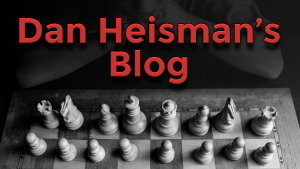Q&A with Coach Heisman Feb 15, 2013
One of the final questions on today's show was "What do you consider the game in chess history that, if I study, I will learn the most?" (I paraphrase)
This question raises three important issues:
- An unannotated "pure" game is only worth what the reader is able to get out of it. But a heavily annotated game is mostly worth the instructive level of the annotations rather than the moves by themselves.
- What can be a very instructive game to help someone go from 2400 to 2450 might be absolutely worthless helping someone else go from 1400 to 1450. As a general observation, subtle positional ideas help very strong players while consistent, basic safety issues help the average tournament player, and certainly those rated below that level.
- Highly praised grandmaster games rarely feature the type of mistakes - even for the loser - that would reflect on the kind of mistakes the average player makes to lose games. In fact, the loser of these grandmaster games would usually have no trouble beating strong amateur players blindfolded because of the relatively different level of mistakes that amateurs make. That's one reason why some unknown game in my book "The World's Most Instructive Amateur Game Book" might likely be more helpful than a grandmaster's intense notes to Fischer-Spassky 6th game, 1972, which I cited in the show.
Returning to point #1 above, I decided to seek out a game in an instructive anthology (take that link for more on this subject!) like McDonald's Giants of Chess Strategy and compare a note or two with the player's own annotations in his game book. In this case I found an example in Chess is My Life by Anatoly Karpov and Alexandr Roshal. Let's start with move 33 of Karpov-Browne, San Antonio 1972:
In response to this position Karpov has no notes at all, and no additional notes until addressing White's 36th move. McDonald writes on move 33:
"First of all, White ties down the black knight to the defense of the a5 pawn. In any endgame, it's almost always a good idea to force your opponent's pieces to defend pawns, as it restricts their freedom of action. Here White is also clearing the e3 square for the king."
McDonald also has explanatory notes after White's 34th move and Black's 35th. The following is the position before Karpov's 36th move, 36.a3
After 36.a3, Karpov writes "Preparing the king's entry to d3. Now 36...a4 is impossible due to 37.Nb6+ +-"
McDonald's entry for 36.a3 is:
"A little move, but it achieves a lot. If now 36...a4, which seeks to undermine the white knight, White has 37.Nb6+! and 38.Nxa4. Even more crucially, the black king is denied the c5 square: if he plays 36...Kc5 White replies 37.Nxa5! Nxa5 38.b4+ Kb5 39.bxa5 Kxa5 40.Kd4 Ka4 41.Ke5 Kxa3 42.Kf6 and notwithstanding his extra pawn Black is utterly lost because the white king is going to capture all his kingside pawns.
'The primary power of an outside passed pawn lies in its threat to queen. However, as already discussed above, in practical play even more vital can be its secondary value in distracting the enemy king long enough for a massacre to occur on the other wing."
What can we conclude from this? If you are already a strong player, Karpov's scarce notes can be plenty informative, and you can, having already been "bootstrapped" in your understanding of what is happening - learn from these light annotations. For such a stronger player, McDonald's explanations might be unnecessary.
However, if you are looking to improve and you are not yet that strong, the extra explanations, in somewhat gory detail as provided by McDonald, are going to be a lot more helpful. Same game, different amount of helpfulness depending on your level. That's why just asking which game is the most instructive might not be nearly as helpful as asking which books are the most instructive, given a specific base level of assumed readership. Similarly, as noted in reason #3 above, a completely unknown game between two amateurs might, for certain purposes, be even more helpful in getting amateurs of that same level to improve, if it includes notes addressed to the mistakes they make, how to recognize them, and how to minimize their recurrence.
Another question asked what I may have done differently when I first started out which would have helped me. Luckily, I made a quite a few excellent decisions when I started, such as playing in as many long-time-control tournaments as possible, joining a strong chess club, and getting the best players I could to analyze the games with me. Other decisions that I made, such as reading about 2,000 annotated games in my first 3-4 years of play and looking up my games - even my speed games - in an opening encyclopedia (MCO-10 mostly) to ask "If I had to play this game again and my opponent made the same moves, what would I do differently next time?" proved extremely helpful. My rating went from unrated in my first event in July 1966 to 1900 in July 1968 to expert (USCF 2000+) by Labor Day 1969. As noted in the Comments to The Michael de la Maza story, many thought Michael must have cheated with computer help to make similar progress (I didn't, but it's just everyone's opinion); luckily in my day computers were only owned by big corporations and the government and took up entire rooms, so no one accused me of computer help . In any case, I finally replied to the question by stating that the main thing I would have liked to have done differently was to start serious play at a much younger age!
. In any case, I finally replied to the question by stating that the main thing I would have liked to have done differently was to start serious play at a much younger age!
Someone else asked "What's a good opening for beginners?" This turns out to be a more difficult question that surface considerations would imply. For example, suppose we follow the common - and good - advice for beginners to play "open" games that lead to clash of pieces. This is good as it leads to tactics, which must be mastered before any serious strategic subtle play is helpful. But suppose those tactics come "too soon" in the game, and the player starts to believe that early fighting is normal and finishing development incidental, instead of the other way around? That could lead to bad habits, so it turns out the issues are not so one-sided. I did point out that even the dullest openings can eventually turn into tactical monstrosities, while the most sharp openings can supernova into dull positions - or not! So in the long run it is not so much exactly which openings you choose, but rather whether you are learning about the safety issues and opening principles involved with all openings, that really is the driving force. Finally, I noted that gambits where you commonly give up a pawn for open lines and development, such as the Blackmar-Diemar Gambit or the Goring Gambit, can be excellent vehicles for beginners playing White (free attack!) since, even if their attack fails and they end up behind a pawn for no compensation, a similarly rated opponent is unlikely to have the technique to shepherd the game from a pawn-ahead opening into a victorious endgame without a hiccup.
As I emphasized in most shows, besides reviewing your games with strong players (I told a tale of how Mig Greengard said he went from 1900 to 2200 hanging out in a Buenos Aires chess club for a couple of years), the other big thing you want to do to improve is to play many long-time control games slowly. Consistently playing that way helps you learn how to think, consistently make decisions among moves, and analyze carefully - not "Hand-Waving" in analytical positions. One good principle to remember is Never begin a game without the intention of using almost all your time (assuming the game is not ended abruptly by a big mistake). If you don't feel like taking all your time, play a shorter time control where you will. But if you want to learn to analyze carefully, it will require many long time control games over many years. Practice may not make perfect, but it will make "better".
I also noted that playing your blitz games online with the same time increment/delay as your important over-the-board games is one of my least-followed advice, but a common sense one that should be a no-brainer.
Next show Mar 1 is for Diamond-Platinum members. Hope to see you there! Thanks again for all the good questions...

